A BRIEF HISTORY OF POSTAL ART
by Mark Bloch
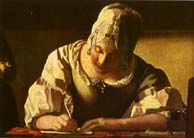 Ed Plunkett, the man credited with coining the phrase New York Correspondence School, once said that postal art probably got its start the day Cleopatra had herself wrapped in a blanket and delivered to Caesar. Before the pony express, before e-mail even, there was good old fashioned hand delivery and people have used it for centuries to issue death threats and profess their love, among other things. As long as there has been mail, there have been people embellishing it in various ways, both physically and, more importantly, perhaps, theoretically.
Ed Plunkett, the man credited with coining the phrase New York Correspondence School, once said that postal art probably got its start the day Cleopatra had herself wrapped in a blanket and delivered to Caesar. Before the pony express, before e-mail even, there was good old fashioned hand delivery and people have used it for centuries to issue death threats and profess their love, among other things. As long as there has been mail, there have been people embellishing it in various ways, both physically and, more importantly, perhaps, theoretically.
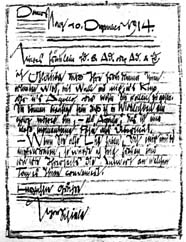 We all know about Vincent van Gogh's letters to his brother Theo that were packed with drawings for painting ideas. Today's mail artists only wonder why the hell he didn't mail that severed ear off to Gaugin in Tahiti. Anyway, as long as there have been artists and there has been post, there has been postal art. Egon Schiele lived a short life in Vienna but he did manage to bang out the beautiful letter (right) in 1912. But like van Gogh, it was just a coincidence-- a by-product of the fact that he was a creative guy with something to say and a place to say it.
We all know about Vincent van Gogh's letters to his brother Theo that were packed with drawings for painting ideas. Today's mail artists only wonder why the hell he didn't mail that severed ear off to Gaugin in Tahiti. Anyway, as long as there have been artists and there has been post, there has been postal art. Egon Schiele lived a short life in Vienna but he did manage to bang out the beautiful letter (right) in 1912. But like van Gogh, it was just a coincidence-- a by-product of the fact that he was a creative guy with something to say and a place to say it.
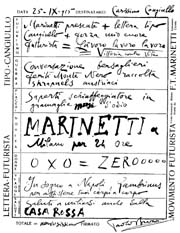 The more theoretical branch of postal art probably has its roots (left) in the Italian Futurists at the turn of the century. They actually used the mail as an artistic device. They sent letters back and forth from World War I praising the beauty of war (they were a sick bunch, what can I tell ya?) but they also used the mail imaginatively, creating innovative stationary, letterheads, logos, postcards and rubber stamps.
The more theoretical branch of postal art probably has its roots (left) in the Italian Futurists at the turn of the century. They actually used the mail as an artistic device. They sent letters back and forth from World War I praising the beauty of war (they were a sick bunch, what can I tell ya?) but they also used the mail imaginatively, creating innovative stationary, letterheads, logos, postcards and rubber stamps.
Speaking of rubber stamps, let's not leave out poor Kurt Schwitters, who called his activities Merz and rubber stamped all over the beautiful collages he made, which also happen to have included postage stamps. Merz was a bit like Dada, the undefinable international anti-art movement that I am not at liberty to discuss right now because I have been sworn to secrecy. Look it up.
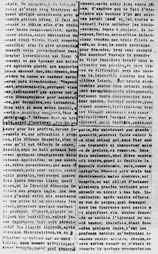 Marcel Duchamp wasn't Dada. He didn't like to join groups. But he did manage to create a seminal piece of mail art in 1916 in the form of four postcards (right) to his next door neighbor that employed perfectly correct language construction to a text that was actually without meaning.
Marcel Duchamp wasn't Dada. He didn't like to join groups. But he did manage to create a seminal piece of mail art in 1916 in the form of four postcards (right) to his next door neighbor that employed perfectly correct language construction to a text that was actually without meaning.
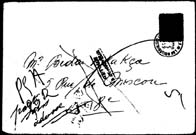 And on and on it went throughout the 1900's. By the 1940's you have Ray Johnson embellishing envelopes in Detroit. And in France, a group called the Noveau Realists were heavily using conceptualism, rubber stamps and (left) Yves Klein's plain blue stamp that he actually used to mail letters. That was in the 1950's, about the time the whole thing starts to explode. A big part of the explosion was not only Ray Johnson, who saw the mail as a performance piece that fused with his collage-making activities, but it was about the time that Fluxus got started. And some of the Noveau Realists were also associated with Fluxus.
And on and on it went throughout the 1900's. By the 1940's you have Ray Johnson embellishing envelopes in Detroit. And in France, a group called the Noveau Realists were heavily using conceptualism, rubber stamps and (left) Yves Klein's plain blue stamp that he actually used to mail letters. That was in the 1950's, about the time the whole thing starts to explode. A big part of the explosion was not only Ray Johnson, who saw the mail as a performance piece that fused with his collage-making activities, but it was about the time that Fluxus got started. And some of the Noveau Realists were also associated with Fluxus.
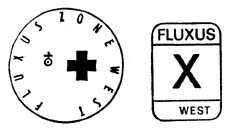
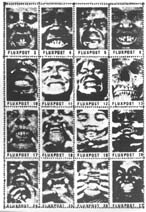 Like mail art, and like Ray Johnson, and like Dada and Futurism and, well, all of it, Fluxus is complex and its roots are difficult to trace. But John Cage had something to do with it and so did the fact that it was a movement, of sorts, that eventually took shape in several countries at once. Like Dada only different.
Like mail art, and like Ray Johnson, and like Dada and Futurism and, well, all of it, Fluxus is complex and its roots are difficult to trace. But John Cage had something to do with it and so did the fact that it was a movement, of sorts, that eventually took shape in several countries at once. Like Dada only different. 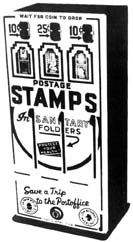 So these people needed to communicate and they did it by mail. But people like George Maciunas (left) and Robert Watts (right) also made stamp sheets and machines to distribute them. And the people they corresponded with in Japan and Germany (like Joseph Beuys, above center) and all over the place were also corresponding with other people in Eastern Europe and you see, over there, behind the Iron Curtain as they liked to call it in those days, it was a life or death situation. You didn't want to get caught saying weird stuff but you wanted to correspond and communicate so the Eastern European art network grew more out of necessity than out of an idea to make art. But there was art involved too, because these people were artists.
So these people needed to communicate and they did it by mail. But people like George Maciunas (left) and Robert Watts (right) also made stamp sheets and machines to distribute them. And the people they corresponded with in Japan and Germany (like Joseph Beuys, above center) and all over the place were also corresponding with other people in Eastern Europe and you see, over there, behind the Iron Curtain as they liked to call it in those days, it was a life or death situation. You didn't want to get caught saying weird stuff but you wanted to correspond and communicate so the Eastern European art network grew more out of necessity than out of an idea to make art. But there was art involved too, because these people were artists.
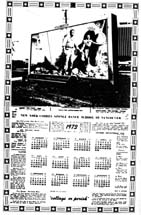 Well finally it all hit the fan in the sixties, about the time everything else hit the fan. And what happened was that Ray Johnson started his correspondence school and it got turned into a corresponDANCE school, meaning that all the networks grew together and it was like a big dance that was traveling the world by mail. And some people called The Image Bank in Canada (left) started circulating mail lists and so did an American guy also living in Canada named Dana Atchley
Well finally it all hit the fan in the sixties, about the time everything else hit the fan. And what happened was that Ray Johnson started his correspondence school and it got turned into a corresponDANCE school, meaning that all the networks grew together and it was like a big dance that was traveling the world by mail. And some people called The Image Bank in Canada (left) started circulating mail lists and so did an American guy also living in Canada named Dana Atchley  who called himself Spaceco. Now Spaceco was one of the many official-sounding names that the artists started to use to mock the postal system and other bureaucracies. And all the rubber stamps that had their place earlier in the century began to come back to satirize the satirizations. Because when art is travelling the planet at the speed of a hundred artists per hour, it all gets cut up and recycled and spit out the other end.
who called himself Spaceco. Now Spaceco was one of the many official-sounding names that the artists started to use to mock the postal system and other bureaucracies. And all the rubber stamps that had their place earlier in the century began to come back to satirize the satirizations. Because when art is travelling the planet at the speed of a hundred artists per hour, it all gets cut up and recycled and spit out the other end.
It all began to be known as mail art but I prefer postal art because POST is a better pun. And to me it's accurate, because once the big network started, you didn't need art anymore. But art or not, that's how it spread to more than 50 countries and thousands of people all over the world. Your turn.
Back to the One World Postal Art Show
Back to PANMODERN.com
 Ed Plunkett, the man credited with coining the phrase New York Correspondence School, once said that postal art probably got its start the day Cleopatra had herself wrapped in a blanket and delivered to Caesar. Before the pony express, before e-mail even, there was good old fashioned hand delivery and people have used it for centuries to issue death threats and profess their love, among other things. As long as there has been mail, there have been people embellishing it in various ways, both physically and, more importantly, perhaps, theoretically.
Ed Plunkett, the man credited with coining the phrase New York Correspondence School, once said that postal art probably got its start the day Cleopatra had herself wrapped in a blanket and delivered to Caesar. Before the pony express, before e-mail even, there was good old fashioned hand delivery and people have used it for centuries to issue death threats and profess their love, among other things. As long as there has been mail, there have been people embellishing it in various ways, both physically and, more importantly, perhaps, theoretically.








